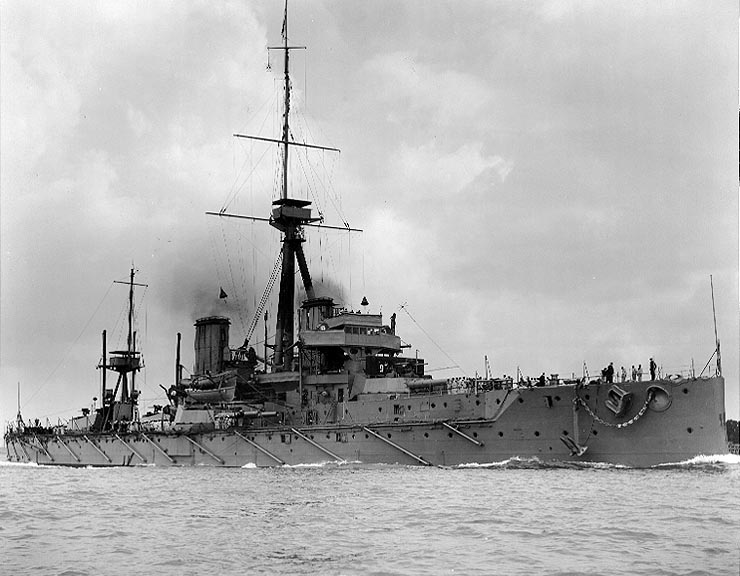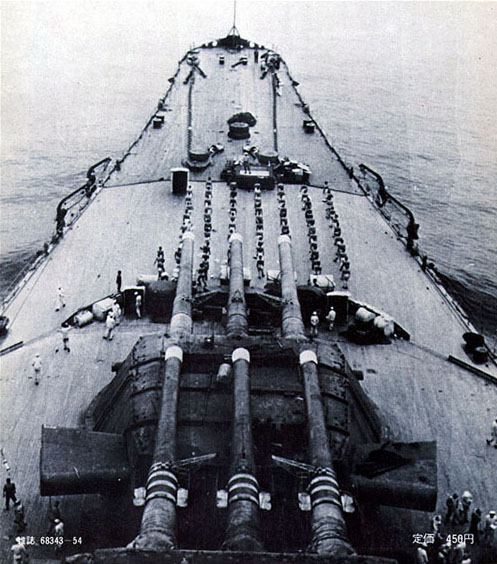At EQ's behest, and for your viewing pleasure I hereby present:
The Evolution of New England Battleships in A Brave New World
Dreadnought
The
Dreadnought-class Battleship was developed in 1890 by the Charleston Shipyard in Boston, New England, at the behest of the New England Navy. The design revolutionized naval warfare.
Dreadnought carried ten 12-inch naval guns on 5 dual turrets, almost triple the number of guns on her predecessors, who usually possessed only four guns, generally of 8 or 10 inch caliber. The ship was 527 feet long and 82 feet abeam, drawing 26 feet of water and displacing 18,500 tons. As the design was developed, it became apparent to leaders in the Navy the impact such a ship would have on the world. Not only was
Dreadnought better armed and armored than other capital ships at the time, she was also faster, able to manage over 20 knots, whereas many large warships built before her struggled to make even 15 knots. This gave her yet another advantage in combat. However, the
Dreadnought-class did not get its first taste of combat under New England until 1912, during the war in China. By that time, the end was drawing near for the
Dreadnoughts, as a new level of naval technology had recently been unveiled.
Dreadnought under way on her maiden voyage, taken from the destroyer
Edmund Hartt, 1890. Courtesy of the Naval War Museum.
The
Dreadnought John Adams on patrol off the coast of Nova Scotia during the Great War. Released 1907. Artist Unknown.
Victory
The unveiling of the new
Victory-class Battleship in 1911 was another large step forward in naval thinking. Unlike its predecessors, the
Victory was powered by oil, rather than coal. This allowed it to store greater amounts of fuel, and more importantly, made it near invisible, as the ships produced far less smoke than other designs, such as the
Atlantic-class. The
Victory-class also had a far larger crew than any previous battleship, housing over 1000 sailors and officers, 1.5 times the complement of a
Dreadnought. She was also the first ship to have all her guns mounted on turrets, above the waterline, whereas most earlier ships had guns mounted in fixed positions under the gunwales, leaving them useless in high seas, or when the ship was heeling heavily, and giving
Victory a far greater arc of fire.
Victory also featured the first use of radio as a means of communication in a ship-to-ship basis, as well as ship-to-shore. This allowed
Victories to communicate instantly not only with each other, but receive intelligence, reports and orders from land based units as well.
Victory was 562 feet long, 93 wide amidships, drew 21 feet of water, and weighed over 27,000 tons. The main armament of a
Victory was twelve 12 inch guns, mounted on three quadruple turrets. Her use of oil rather than coal and better designed, more powerful engines gave her much greater speed than her predecessor.
Victories became one of the most numerous ships in the New England Navy, serving all over the world
Victory on a good will tour to New York City, shortly after Albanys admittance into New England, 1913. Note the distinctive 4-gun turrets. Courtesy of the City of New York
Imperial
Upon its launching in 1919, the new
Imperial class of Battleship showed the future of naval warfare. Her twelve 14 inch guns were the largest yet used on any ship (and set the precedent of new ships upgunning older models), and her improved armor, both on deck and below the waterline, helped shape all future battleship designs.
Imperialdisplaced 33,000 tons, was 624 feet long, 99 feet wide and drew 31 feet. The
Imperial class was also one of the fastest battleships ever designed. This gave the class a large advantage over its earlier contemporaries, primarily the
Atlantic class Battleship. During the 3rd Battle of Jamaica in 1934, though outnumbered and under attack from two sides, the
Imperial-class Battleship
Twilight ((OOC: Not named after that abomination of a book series)), and the
Victory-class Battleship
Audacious held the United Collectives of North Americas fleet at bay, while New England troop transports evacuated from Jamaica. Though
Audacious was sunk, firing her guns as she did so,
Twilight was able to retreat through the shattered remains of the Socialist Union of South Americas fleet, using her superior speed to put distance between herself and the enemy and find shelter in Puerto Rico. She was sunk in the Communist air attack there the following year. Even after being overshadowed by larger classes such as the
Eclipse and
Titan,
Imperials still saw service in the smaller and more far-flung New England fleets, and those of the former United Nation States of America.
The
Imperial-class Battleship
Twilight takes a direct hit amidships from a Communist Bomber during the Battle of Puerto Rico, just prior to sinking.
The
Imperial-class Battleship
Conqueror fires at Arabian positions during the conflict with Rashid Arabia, 1939. Courtesy of the Naval War Museum.
Eclipse
With the unveiling of the
Constantine-class Battleship by the Russians in 1929, New England naval thinkers began the process of creating a new level of Battleship. As had been the case before, and continues to this day, New England endeavored to stay at least one level above any potential opposition in terms of naval warfare. The
Constantine offered a fair match to the
Imperial, thus forcing a call for new designs. The product of this was the
Eclipse, a huge, 845 foot long ship, 108 feet wide, drawing 36 feet of water. She mounted a main battery of nine 16 inch guns, along with numerous smaller weapons, including the first built in anti-air weapons to be incorporated on a warship. These twenty 5-inch cannons, also used against smaller ships, were designed to be able to shoot and destroy zeppelins, specifically Zeppelin Dreadnoughts. The guns could throw up flak and other anti aircraft rounds at a prodigious rate. There placement in ten twin turrets throughout the ship proved highly effective, with the fire from the
Eclipse-class Battleships
Executor and
Exactor taking down numerous squadrons of Communist planes during the raid on Puerto Rico.
Eclipses, when used in conjunction with
Titans are able to inflict enormous damage on enemy warships, as witnessed by the near total destruction of the UCNA fleet off the coast of Puerto Rico in 1935
Eclipse sails out of Boston Harbor on patrol. Note the elongated bow and stern, making her almost as long as
Titan would be upon her launching, 1933. Courtesy of the Naval War Museum
The
Eclipse-class Battleship
Executor on patrol in the Caribbean during the Communist War. Note the camouflage pattern painted on her sides, to make her harder to spot from both ships and planes, 1936. Courtesy of the Puerto Rican War Museum.
Titan
The
Titan-class Battleship is a giant among ships. Displacing over 70,000 tons fully loaded,
Titan was 860 feet long, 130 feet wide and drew almost 35 feet. Her main armament was nine massive 18 inch naval guns. These monsters were capable of firing a shell weighing 3000 lbs over 26 miles, meaning that a
Titan could engage enemy ships over the visual horizon. This first strike ability was augmented by the four scout biplanes that each
Titan carried. Using radios, the small planes could signal back hits or misses, as well as the range to targets. They were seaplanes, lowered off the deck into the water by cranes on the ships stern, taking off and landing by sea.
Titan was unique in being the first warship to carry such planes.
Titan was also the first Battleship to feature anti aircraft emplacements specifically for shooting down enemy planes, rather than the larger guns for shooting attacking zeppelins.
A snapshot of
Titans two forward turrets, each housing three 18 inch naval guns.
The
Titan class Battleships
Behemoth (foreground) and
Imperial Spirit (background) at anchor outside of San Juan during the Communist war. The two ships formed the core of the new 4th Fleet, sent to replace and relieve those ships damaged and sunk during the 3rd Battle of Jamaica and later the Air Raid on Puerto Rico. It is believed that this picture was taken from the bridge of the Light Cruiser
Providence in 1937. Courtesy of the Providence Historical Society.
Capital Class Ships in the New England Navy as of 1938
Victories
Victory
Illustrious
Defender
Interdictor
Fearless
Vanguard
Intrepid
Republic
Aegis
Harbinger
Aggressor
Repulse
Resolute
Thunder
Imperials
Imperial
Turbulent
Aurora
Torrent
Conqueror
Doombringer
Helot
Arbiter
Eclipses
Eclipse
Enforcer
Executor
Endurance
Eminence
Nimbus
Indomitable
Incursion
Titans
Titan
Behemoth
Imperial Spirit
Goliath
Colossus
Punisher
Juggernaut
 .
.









